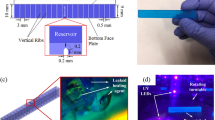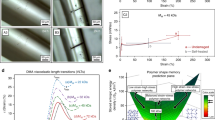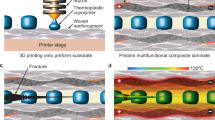Abstract
Structural polymers are susceptible to damage in the form of cracks, which form deep within the structure where detection is difficult and repair is almost impossible. Cracking leads to mechanical degradation1,2,3 of fibre-reinforced polymer composites; in microelectronic polymeric components it can also lead to electrical failure4. Microcracking induced by thermal and mechanical fatigue is also a long-standing problem in polymer adhesives5. Regardless of the application, once cracks have formed within polymeric materials, the integrity of the structure is significantly compromised. Experiments exploring the concept of self-repair have been previously reported6,7,8, but the only successful crack-healing methods that have been reported so far require some form of manual intervention10,11,12,13,14,15,16,17,18. Here we report a structural polymeric material with the ability to autonomically heal cracks. The material incorporates a microencapsulated healing agent that is released upon crack intrusion. Polymerization of the healing agent is then triggered by contact with an embedded catalyst, bonding the crack faces. Our fracture experiments yield as much as 75% recovery in toughness, and we expect that our approach will be applicable to other brittle materials systems (including ceramics and glasses).
This is a preview of subscription content, access via your institution
Access options
Subscribe to this journal
Receive 51 print issues and online access
$199.00 per year
only $3.90 per issue
Buy this article
- Purchase on Springer Link
- Instant access to full article PDF
Prices may be subject to local taxes which are calculated during checkout




Similar content being viewed by others
References
Talrega, R. Damage development in composites: mechanisms and modelling. J. Strain Anal. Eng. Des. 24, 215–222 (1989).
Talrega, R. (ed.) Damage Mechanics of Composite Materials 139–241 (Elsevier, New York, 1994).
Gamstedt, E. K. & Talrega, R. Fatigue damage mechanisms in unidirectional carbon-fibre-reinforced plastics. J. Mater. Sci. 34, 2535–2546 (1999).
Pecht, M. G., Nguyen, L. T. & Hackim, E. B. Plastic-Encapsulated Microelectronics 235–301 (John Wiley & Sons, New York, 1995).
Lee, L. H. Adhesive Bonding 239–291 (Plenum, New York, 1991).
Wool, R. P. Polymer Interfaces: Structure and Strength Ch. 12 445–479 (Hanser Gardner, Cincinnati, 1995).
Dry, C. & Sottos, N. in Smart Structures and Materials 1993: Smart Materials (ed. Varadan, V. K.) Vol. 1916, 438 (SPIE Proceedings, SPIE, Bellingham, WA, 1993).
Dry, C. Procedures developed for self-repair of polymeric matrix composite materials. Comp. Struct. 35, 263–269 (1996).
Wiederhorn, S. M. & Townsend, P. R. Crack healing in glass. J. Am. Ceram. Soc. 53, 486–489 (1970).
Stavrinidis, B. & Holloway, D. G. Crack healing in glass. Phys. Chem. Glasses 24, 19–25 (1983).
Inagaki, M., Urashima, K., Toyomasu, S., Goto, Y. & Sakai, M. Work of fracture and crack healing in glass. J. Am. Ceram. Soc. 68, 704–706 (1985).
Jud, K. & Kausch, H. H. Load transfer through chain molecules after interpenetration at interfaces. Polym. Bull. 1, 697–707 (1979).
Jud, K., Kausch, H. H. & Williams, J. G. Fracture mechanics studies of crack healing and welding of polymers. J. Mater. Sci. 16, 204–210 (1981).
Kausch, H. H. & Jud, K. Molecular aspects of crack formation and healthy in glassy polymers. Plastic Rubber Proc. Appl. 2, 265–268 (1982).
Wool, R. P. & O'Conner, K. M. A theory of crack healing in polymers. J. Appl. Phys. 52, 5953–5963 (1982).
Wang, E. P., Lee, S. & Harmon, J. Ethanol-induced crack healing in poly(methyl methacrylate). J. Polym. Sci. B 32, 1217–1227 (1994).
Lin, C. B., Lee, S. & Liu, K. S. Methanol-induced crack healing in poly(methyl methacrylate). Polym. Eng. Sci. 30, 1399–1406 (1990).
Raghavan, J. & Wool, R. P. Interfaces in repair, recycling, joining and manufacturing of polymers and polymer composites. J. Appl. Polym. Sci. 71, 775–785 (1999).
Mura, T. Micromechanics of Defects in Solids 2nd edn (Kluwer Academic, New York, 1987).
Grubbs, R. H. & Tumas, W. Polymer synthesis and organotransition metal chemistry. Science 243, 907–915 (1989).
Schwab, P., Grubbs, R. H. & Ziller, J. W. Synthesis and applications of RuCl2(=CHR′)(PR3)2: the influence of the alkylidene moiety on metathesis activity. J. Am. Chem. Soc. 118, 100–110 (1996).
Sanford, M. S., Henling, L. M. & Grubbs, R. H. Synthesis and reactivity of neutral and cationic ruthenium(II) tri(pyrazolyl)borate alkylidenes. Organometallics 17, 5384–5389 (1998).
Mostovoy, S., Croseley, P. B. & Ripling, E. J. Use of crack-line-loaded specimens for measuring plane-strain fracture toughness. J. Mater. 2, 661–681 (1967).
Acknowledgements
This work has been sponsored by the University of Illinois Critical Research Initiative Program and the AFOSR Aerospace and Materials Science Directorate. Electron microscopy was carried out in the Center for Microanalysis of Materials, University of Illinois, which is supported by the US Department of Energy.
Author information
Authors and Affiliations
Corresponding author
Rights and permissions
About this article
Cite this article
White, S., Sottos, N., Geubelle, P. et al. Autonomic healing of polymer composites. Nature 409, 794–797 (2001). https://doi.org/10.1038/35057232
Received:
Accepted:
Issue Date:
DOI: https://doi.org/10.1038/35057232
This article is cited by
-
Synthesis and characterisation of microcapsules for self-healing dental resin composites
BMC Oral Health (2024)
-
Effect of graphene incorporation on properties of epoxy-based self-healing coatings
Polymer Bulletin (2024)
-
The Effect of Ionic Liquids Incorporation on the Self-healing Behavior of the Bitumen
Arabian Journal for Science and Engineering (2024)
-
Fabrication of corrosion inhibiting microcapsules functional coating and their high-efficiency corrosion resistance
Rare Metals (2024)
-
Structural engineered living materials
Nano Research (2024)
Comments
By submitting a comment you agree to abide by our Terms and Community Guidelines. If you find something abusive or that does not comply with our terms or guidelines please flag it as inappropriate.



